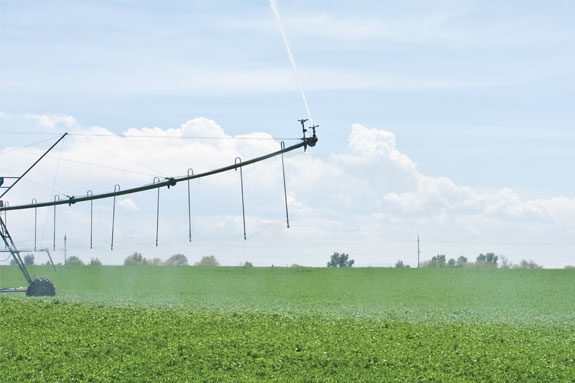Younger stands will not have as well-developed crowns or root structures and will be more prone to drought-induced stresses. Following are some strategies for maintaining alfalfa when irrigation water is in short supply.
Maintain root carbohydrate levels
Alfalfa roots store starch for the plant’s winter survival, spring growth and post-harvest regrowth. During the winter months, alfalfa crowns and roots respire, using stored energy to survive.
If the crown and roots were fully charged the previous fall, under normal conditions winter survival is of little concern. However, if plants were stressed in the fall, they will be more vulnerable to extremes in the environment.
Thus, fall management is very important for winter survival and initial spring growth.
As soils warm in the spring, the new branch or crown buds begin growth, fed by mobilized starch stored in the crown and roots. The new growth continues to draw upon the stored energy until topgrowth reaches about eight inches in height.
Subsequent growth reverses the energy flow back to the storage structures in the roots and crown. Starch concentration peaks at full bloom. In a drought year, where fewer-than-normal harvests will likely be made, it is important to ensure root reserve recharge before each harvest. Avoid harvesting early. Weakened plants are more prone to winter injury.
Plant nutrition
Soil testing is important in a drought year. Nitrogen fixation by rhizobia will be reduced under moisture stress. This means that lower-than-normal applications of plant nutrients are necessary.
However, well-fed plants withstand drought conditions better and use less water to produce comparable amounts of forage for harvest.
Adequate phosphorous is necessary for root growth and new stem bud development. Overfertilization with potassium may lead to excessive amounts in cattle feed (over 3.5 percent). This can lead to metabolic disorders, calving problems and displaced abomasums. Alfalfa’s boron needs should be maintained; however, excessive boron in feed is also toxic to livestock.
Normally, alfalfa does not accumulate excessive nitrates in the forage. However, drought-stressed alfalfa can accumulate potentially toxic levels of nitrates.
In nitrate-N concentrations, expressed on a 100 percent dry matter basis, less than 0.17 percent (1700 parts per million or ppm) should be safe in hay and haylage. If fed as greenchop or grazed, the upper limits are 0.34 percent (3400 ppm) and 0.45 percent (4500 ppm), respectively. Growers may want to add a test for nitrate-N when submitting samples for forage quality analyses.
Weed control
Weeds waste valuable irrigation water. Identify and control weeds early in the season to conserve as much water for the alfalfa crop as possible. Follow all label directions when handling and applying herbicides.
If weed infestations are high, consider replacing the stand with a more water-efficient rotation crop. Rotating alfalfa is effective in reducing certain weeds, insect, disease and nematode pests.
Irrigation management
Alfalfa grown for forage in the arid Northwest normally requires from 1.8-acre feet (for 180-day growing season) to 3.2-acre feet (for 200-day growing season) of water. When irrigation supplies are limited, growers may want to alter their normal irrigation management.
In some heavier soils, moisture accumulation from the previous fall irrigation and winter precipitation may be sufficient to support growth for the first harvest. Monitor soil moisture, and irrigate only if moisture stress is likely to impact first-cutting yields.
Plant stress can occur when available soil moisture decreases below 50 percent. If sufficient water is available for irrigation after first harvest, use it early in the season. In a four-cut harvest system, the first cutting usually makes up about 35 to 38 percent of the year’s total forage produced. In a five-cut harvest system, first-cutting yields contribute about 27 percent.
Drought-stressed alfalfa matures earlier, thus forage quality will peak earlier and degrade more rapidly than under normal conditions. Growers should analyze markets to determine whether to maximize forage quality or season yield.
Managing for higher season yields will increase the chances for longer stand life.
Under moderate moisture stress, alfalfa plants have the ability to go into a drought-induced dormancy. Growth slows or completely ceases until moisture returns.
Plant death due to extended drought is more likely in sandy soils. Upon rewetting of soils, plants will resume growth, but they will grow more slowly than normal. Avoid irrigating drought-induced dormant alfalfa until late in the fall, when lower temperatures will maintain dormancy. This will preserve stored root reserves for winter maintenance and spring growth.
Minimize wheel and animal traffic
Dormant alfalfa is susceptible to damage by machinery and overgrazing. Crown buds may have formed, waiting for sufficient moisture and warmth to grow. Injury to crown tissue from wheel and hoof traffic can lead to infection by disease organisms, shortening stand life. FG
—Excerpts from Washington State University Extension website
PHOTODrought-stressed alfalfa matures earlier, thus forage quality will peak earlier and degrade more rapidly than under normal conditions.Photo by FG staff.










